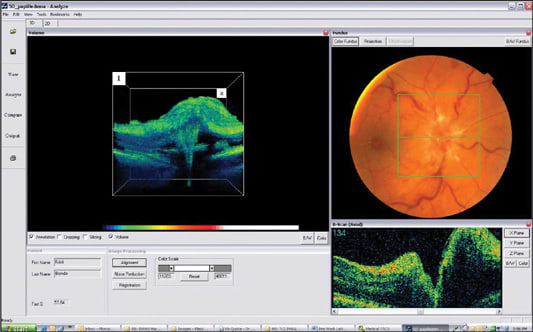Spotlight ON TECHNOLOGY & TECHNIQUE
3D OCT-1000
A Fourier-domain system acquires more data in less time.
By Leslie Goldberg, Associate Editor
The Topcon 3D OCT-1000
(Topcon, Paramus, N.J.), combines Fourier-domain technology, a nonmydriatic retinal camera and Topcon's exclusive TrueMap 3D OCT software into a single system.
Fourier- vs. Time-Domain Systems
SriniVas R. Sadda, M.D., associate professor of ophthalmology at the Doheny Eye Institute of the Keck School of Medicine in Los Angeles, has been using the 3D OCT-1000 in a research capacity for the past 2 years. He says that Fourier-domain systems have three principal improvements over time-domain OCT systems — they deliver more data in less time at a higher resolution.
"In the real world, this means that in the 8 seconds it takes us to get six scans using time-domain OCT, we scan get 128 scans in 4 seconds with the Fourier OCT. Additionally, with the time-domain systems, it is difficult for patients to keep their eyes fixated — the eye tends to wander.
Fourier scans are 50 times faster. With time-domain systems, the number of scans and the location of the scan are limited. The high speed of the Fourier device means that there is less movement and artifact in the images."
3-D Imaging
In addition to these advantages, users are able to get a dense data set – which creates a 3-D image with the Fourier, explains Dr. Sadda. "This greater volume of data helps doctors to understand how to go about treating a patient," he adds. "Also, with the OCT-1000, you get a color photo at the end of the scan. The picture can be compared to the OCT scan for a better correlation between fundus findings and the OCT features."

Dr. Sadda explains that the 3-D image looks like an artistic 3-D rendering of the retina. "With the OCT-1000, we can actually peel back layers of the retina. This is helpful in two regards. First, a 3-D capability is helpful for a doctor's understanding of the patient's anatomy and for the planning of their care," says Dr. Sadda.
"Another advantage of the high speed is it allows for alignment of where exactly in the retina you need to focus. Instead of getting a few standard lines of data, you get a data set or series of lines for these sections of the retina."
Because of the density of information provided by these scans, physicians are able to tell exactly where problem lies. "For example, if I see a red dot in the retina, I can click on the red dot and the system will pull up the spot on the OCT," explains Dr. Sadda. "It will show me if the dot is actually in the retina, above it or below it — this is not the case with time-domain systems.
"The OCT-1000 has point-to-point registration — this actually helps with identification of disease," says Dr. Sadda. "The ability to see a certain section in the stack makes a doctor a better interpreter of disease."
Registration and Data Collection
Another benefit of the Fourier system is its registration ability. "With a Fourier-domain system you are able to track history more accurately," says Dr. Sadda. "Once you are treating a patient, you can compare the area of concern with the exact spot you were tracking when you last saw him/her. This registration ability allows you to track progression more accurately. This is not possible with time-domain — there are not enough data gathered," says Dr. Sadda.

Figure. An image from the Topcon 3D OCT-1000 (including 3-D, color fundus and B-scan images) depicting papilledema.
Dr. Sadda says that he is able to make certain diagnoses that were difficult before. He says that this has a huge impact on patient care. "The increased sensitivity of the device allows you to see things that you could not see with the time-domain system. If you only get a few images taken, you might miss a pocket of fluid — it falls between the scan lines." OM
Dr. Sadda shares royalties from software licensed to Topcon by the Doheny Eye Institute. Topcon received clearance to market the 3D OCT-1000 in June 2007.








